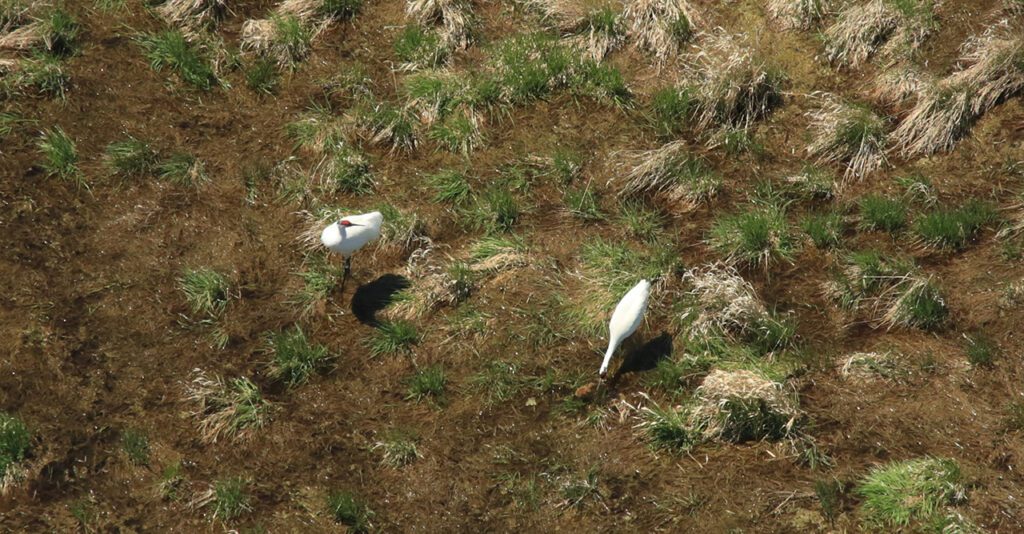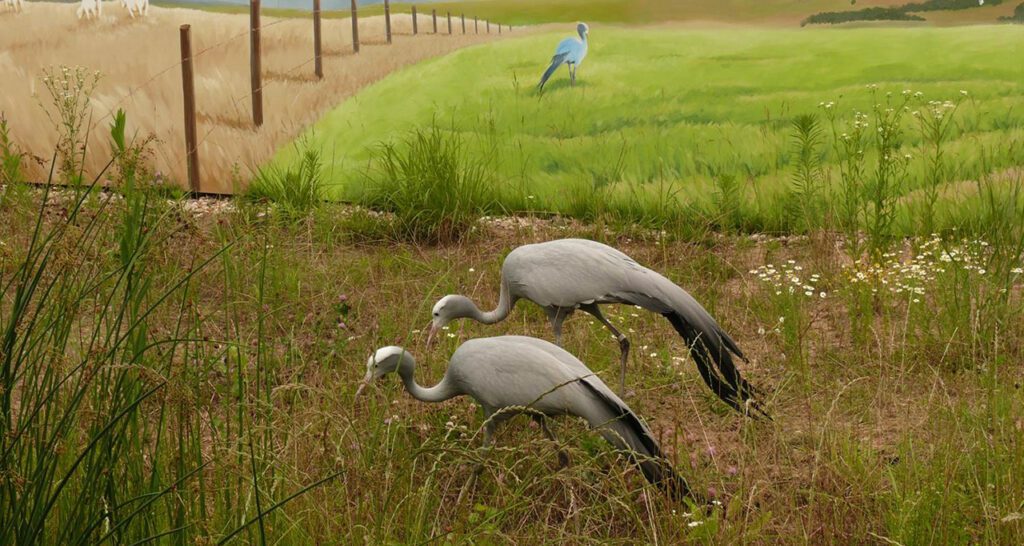Cranetivities: Cacophonous Crane Calls!
Welcome back to Cranetivities! In this week’s exciting edition, you’ll get to listen to the raucous noises that cranes make. Put on your listening ears and become a crane sound connoisseur! See last week’s edition of Cranetivities here.
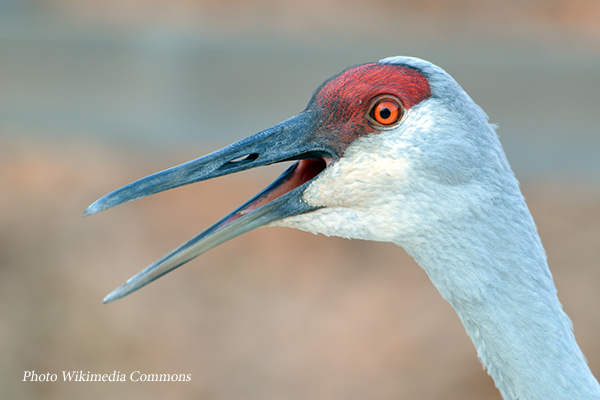
Activity Description: Do you know what cranes sound like? This week’s Cranetivities explores the distinctive crane calls that Aldo Leopold aptly dubbed, “the trumpet in the orchestra of evolution.” You’ll get to hear the noises that all 15 species make, and you’ll learn how they make those noises. Scroll down for the noisiest Cranetivities yet!
Grades: All ages
Time estimate: 1 to 2 hours
Topics covered: Reading, science, arts and crafts, music
Materials needed: Internet connection, device to play audio (computer/phone speaker), toilet paper or paper towel tube, wax paper, rubber band and a sharp pencil
Adult involvement: Minimal
Indoor or outdoor: Indoor
Links:
Journey North Crane Sounds Activity
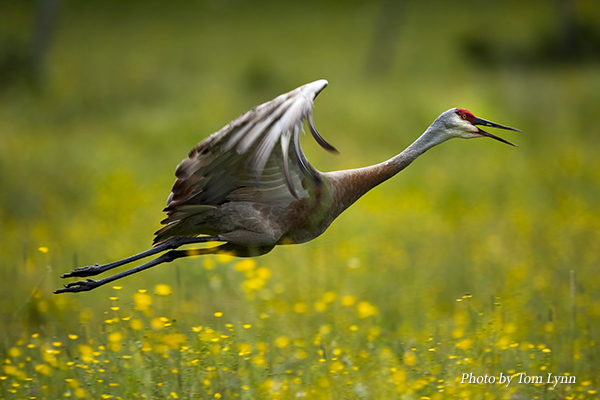
“High horns, low horns, silence and finally a pandemonium of trumpets, rattles, croaks and cries that almost shakes the bog with its nearness… When we hear his call, we hear no mere bird. We hear the trumpet in the orchestra of evolution.” – Aldo Leopold, Marshland Elegy
These beautiful words from Aldo Leopold, one of the most important figures in the field of wildlife management, describe the cacophonous calls of the Sandhill Crane. For those who have heard them, Leopold’s description certainly rings true. Cranes are famous for having loud, distinctive calls. One crane species is even named for its resounding “Whoop!” Do you know which one? In this week’s Cranetivities you will learn how and why cranes sound the way they do, and you might even get to make some music yourself!
Begin with an exploration of the International Crane Foundation’s Species Field Guide. By visiting the web page for each of the 15 species, you will be able to listen to the calls of most of the cranes of the world. As you’re listening, ask yourself the following questions:
What is similar about the calls of each species?
What differences (duration, tone or pitch) do you notice between the calls of each species?
Which species’ call is your favorite and why?
Once you’ve listened to all the calls, test your knowledge! This link will take you to one of the crane species’ guard calls. Try to figure out which species it is! Scroll down to the end of this post for the answer.
Next, check out these YouTube videos of different crane species performing unison and guard calls. Pay particular attention to the differences between the calls of the Whooping Crane and the Sandhill Crane, as these are two commonly mixed-up species. See if you can hear the “whoop, whoop” sound from the Whooping Cranes and the “karoo, karoo” sound from the Sandhill Cranes.
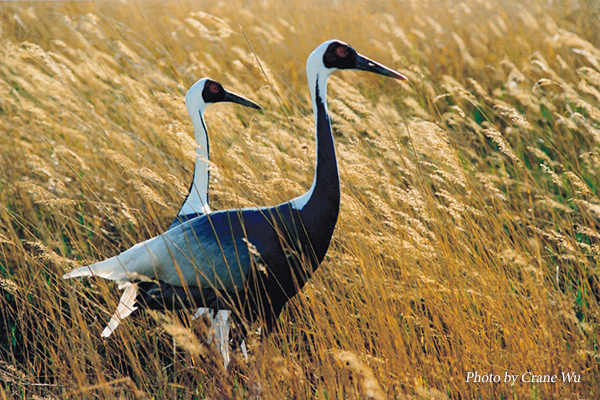 As you’re watching the videos, take note of the cranes’ behavior during the unison calls. Do they stand still or move around while they’re calling? What seems to be happening leading up to the calls? The researchers and aviculture staff at the International Crane Foundation observe crane behaviors like these every day, both on our site and in the field. Their careful observation over the past several decades has helped us learn important information about crane calls, like how they make such loud sounds, the different types of calls they can make, and why they do all of those calls. Let’s explore these ideas!
As you’re watching the videos, take note of the cranes’ behavior during the unison calls. Do they stand still or move around while they’re calling? What seems to be happening leading up to the calls? The researchers and aviculture staff at the International Crane Foundation observe crane behaviors like these every day, both on our site and in the field. Their careful observation over the past several decades has helped us learn important information about crane calls, like how they make such loud sounds, the different types of calls they can make, and why they do all of those calls. Let’s explore these ideas!
How do cranes make such distinct, resounding noises? We can answer this question by looking inside a crane’s body at its windpipe, or trachea. The diagram below shows the tracheae of several large bird species, including the Whooping Crane.
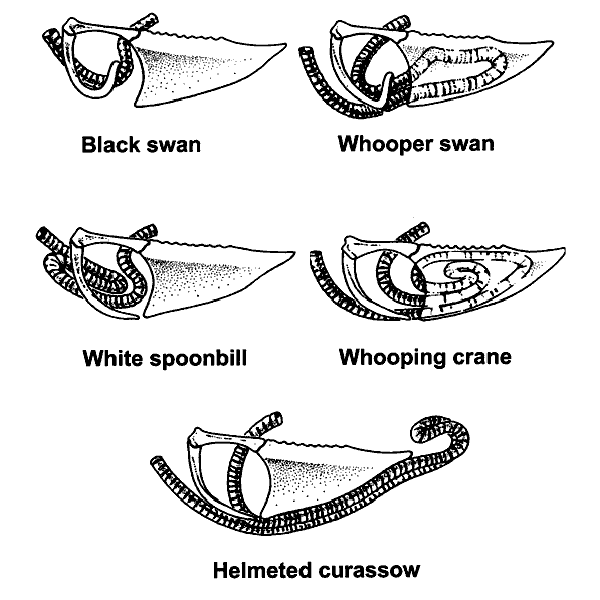
Image from Inhaled Anesthesia in Birds in Recent Advances in Veterinary Anesthesia and Analgesia: Companion Animals.
All cranes have an elongated trachea that is coiled up inside the chest cavity. If you compare the trachea of the Whooping Crane to that of the other bird species in the above diagram, you can see that the Whooping Crane trachea is longer and more coiled than the others. Having an elongated windpipe with lots of coils enables cranes to make loud, resonant sounds – the longer the trachea, the louder the bird! Some people even compare crane tracheae to French Horns, below. Do you see why this comparison is made?
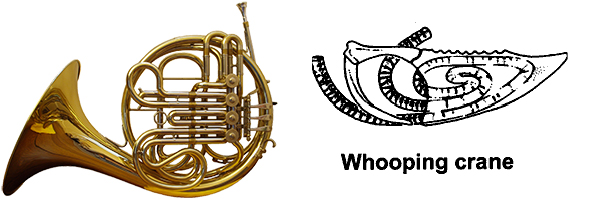
Now that we know how cranes make their calls, let’s learn why they might be doing this behavior. Journey North, a Wisconsin-based organization that focuses on community science projects, has a short activity that you can explore to learn more about Whooping Crane sounds. This activity will take you through some definitions and examples of the types of two calls that cranes make – brood calls and unison calls. You’ll also learn how to tell male and female cranes apart just by listening to their unison call! This is one of the easiest ways that scientists can tell males and females apart in the field, and it’s true across all crane species.
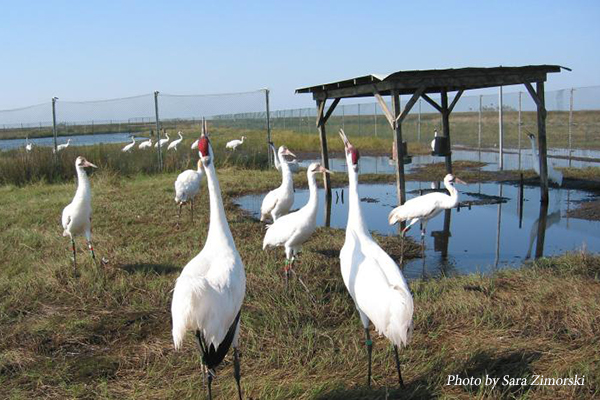
After hearing all those crane calls, you might want to try making some of your own noises! To help you with that, check out this awesome activity that will show you how to make your very own kazoo out of regular household items. You can even decorate yours with pictures of cranes! Remember what you learned about the elongated windpipes of cranes. Feel free to experiment with using paper towel tubes to make your kazoo even longer, or you can try taping two or more toilet paper tubes together. See what happens to the sound of your kazoo when you make it longer!
 In all these activities, we learned about the amazing sounds that cranes make. To many of us, including Aldo Leopold, crane sounds are music to our ears! There are lots of other birds that make interesting sounds, and we encourage you to explore the diverse range of bird sounds around the world. This Bird Song Opera video should give you some ideas for where to start.
In all these activities, we learned about the amazing sounds that cranes make. To many of us, including Aldo Leopold, crane sounds are music to our ears! There are lots of other birds that make interesting sounds, and we encourage you to explore the diverse range of bird sounds around the world. This Bird Song Opera video should give you some ideas for where to start.
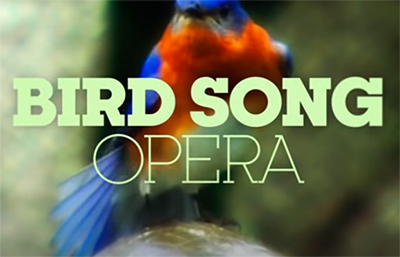 Got feedback? We would love to hear your thoughts on our educational resources. This survey will allow you to provide feedback on our Cranetivities series. If you have used any of our other educational resources, like our From the Field series or our online activity packets, you may provide feedback on those resources here. You may also email us at info@savingcranes.org if you have questions or comments for us, or if you would like to share photos of you and your kids’ crane creations. We will see you next week for a new edition of Cranetivities!
Got feedback? We would love to hear your thoughts on our educational resources. This survey will allow you to provide feedback on our Cranetivities series. If you have used any of our other educational resources, like our From the Field series or our online activity packets, you may provide feedback on those resources here. You may also email us at info@savingcranes.org if you have questions or comments for us, or if you would like to share photos of you and your kids’ crane creations. We will see you next week for a new edition of Cranetivities!
Answer: Siberian Crane
